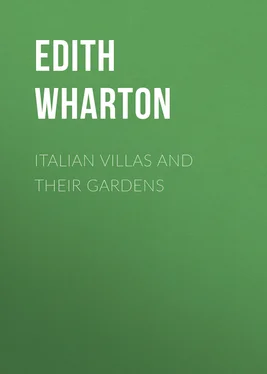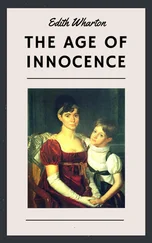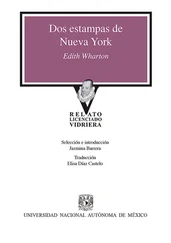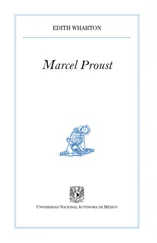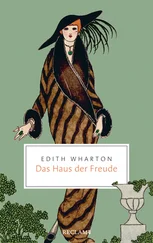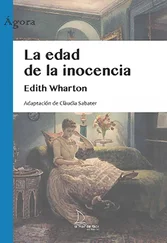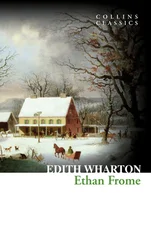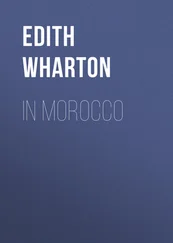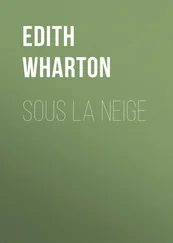Edith Wharton - Italian Villas and Their Gardens
Здесь есть возможность читать онлайн «Edith Wharton - Italian Villas and Their Gardens» — ознакомительный отрывок электронной книги совершенно бесплатно, а после прочтения отрывка купить полную версию. В некоторых случаях можно слушать аудио, скачать через торрент в формате fb2 и присутствует краткое содержание. Жанр: Путешествия и география, foreign_antique, foreign_prose, на английском языке. Описание произведения, (предисловие) а так же отзывы посетителей доступны на портале библиотеки ЛибКат.
- Название:Italian Villas and Their Gardens
- Автор:
- Жанр:
- Год:неизвестен
- ISBN:нет данных
- Рейтинг книги:3 / 5. Голосов: 1
-
Избранное:Добавить в избранное
- Отзывы:
-
Ваша оценка:
- 60
- 1
- 2
- 3
- 4
- 5
Italian Villas and Their Gardens: краткое содержание, описание и аннотация
Предлагаем к чтению аннотацию, описание, краткое содержание или предисловие (зависит от того, что написал сам автор книги «Italian Villas and Their Gardens»). Если вы не нашли необходимую информацию о книге — напишите в комментариях, мы постараемся отыскать её.
Italian Villas and Their Gardens — читать онлайн ознакомительный отрывок
Ниже представлен текст книги, разбитый по страницам. Система сохранения места последней прочитанной страницы, позволяет с удобством читать онлайн бесплатно книгу «Italian Villas and Their Gardens», без необходимости каждый раз заново искать на чём Вы остановились. Поставьте закладку, и сможете в любой момент перейти на страницу, на которой закончили чтение.
Интервал:
Закладка:
Behind the fountain, and in a line with it, a horseshoe-shaped amphitheatre has been cut out of the hillside, surrounded by tiers of stone seats adorned with statues in niches and backed by clipped laurel hedges, behind which rise the ilex-clad slopes of the upper gardens. This amphitheatre is one of the triumphs of Italian garden-architecture. In general design and detail it belongs to the pure Renaissance, without trace of the heavy and fantastic barocchismo which, half a century later, began to disfigure such compositions in the villas near Rome. Indeed, comparison with the grotesque garden-architecture of the Villa d’Este at Tivoli, which is but little later in date, shows how long the Tuscan sense of proportion and refinement of taste resisted the ever-growing desire to astonish instead of charming the spectator.
On each side of the amphitheatre, clipped ilex-walks climb the hill, coming out some distance above on a plateau containing the toy lake with its little island, the Isola Bella, which was once the pride of the Boboli garden. This portion of the grounds has been so stripped of its architectural adornments and of its surrounding vegetation that it is now merely forlorn; and the same may be said of the little upper garden, reached by an imposing flight of steps and commanding a wide view over Florence. One must revert to the architect’s plan to see how admirably adapted it was to the difficulties of the site he had to deal with, and how skilfully he harmonized the dense shade of his ilex-groves with the great open spaces and pompous architectural effects necessary in a garden which was to form a worthy setting for the pageants of a Renaissance court. It is interesting to note in this connection that the flower-garden, or giardino segreto , which in Renaissance gardens almost invariably adjoins the house, has here been relegated to the hilltop, doubtless because the only level space near the palace was required for state ceremonials and theatrical entertainments rather than for private enjoyment.
It is partly because the Boboli is a court-garden, and not designed for private use, that it is less interesting and instructive than many others of less importance. Yet the other Medicean villas near Florence, though designed on much simpler lines, have the same lack of personal charm. It is perhaps owing to the fact that Florence was so long under the dominion of one all-powerful family that there is so little variety in her pleasure-houses. Pratolino, Poggio a Caiano, Cafaggiuolo, Careggi, Castello and Petraia, one and all, whatever their origin, soon passed into the possessorship of the Medici, and thence into that of the Austrian grand dukes who succeeded them; and of the three whose gardens have been partly preserved, Castello, Petraia and Poggio Imperiale, it may be said that they have the same impersonal official look as the Boboli.
Castello and Petraia, situated a mile apart beyond the village of Quarto, were both built by Buontalenti, that brilliant pupil of Ammanati’s who had a share in the planning of the gardens behind the Pitti. Castello stands on level ground, and its severely plain façade, with windows on consoles and rusticated doorway, faces what is now a highway, though, according to the print of Zocchi, the eighteenth-century engraver, a semicircular space enclosed in a low wall once extended between the house and the road, as at the neighbouring Villa Corsini and at Poggio Imperiale. It was an admirable rule of the old Italian architects, where the garden-space was small and where the site permitted, to build their villas facing the road, so that the full extent of the grounds was secured to the private use of the inmates, instead of being laid open by a public approach to the house. This rule is still followed by French villa-architects, and it is exceptional in France to see a villa entered from its grounds when it may be approached directly from the highroad.
Behind Castello the ground rises in terraces, enclosed in lateral walls, to a high retaining-wall at the back, surmounted by a wood of ilexes which contains a pool with an island. Montaigne, who describes but few gardens in his Italian diary, mentions that the terraces of Castello are en pante (sic); that is, they incline gradually toward the house, with the slope of the ground. This bold and unusual adaptation of formal gardening to the natural exigencies of the site is also seen in the terraced gardens of the beautiful Villa Imperiali (now Scassi) at Sampierdarena, near Genoa. The plan of the garden at Castello is admirable, but in detail it has been modernized at the cost of all its charm. Wide steps lead up to the first terrace, where Il Tribolo’s stately fountain of bronze and marble stands surrounded by marble benches and statues on fine rusticated pedestals. Unhappily, fountain and statues have lately been scrubbed to preternatural whiteness, and the same spirit of improvement has turned the old parterres into sunburnt turf, and dotted it with copper beeches and pampas-grass. Montaigne alludes to the berceaux , or pleached walks, and to the close-set cypresses which made a delicious coolness in this garden; and as one looks across its sun-scorched expanse one perceives that its lack of charm is explained by lack of shade.
As is usual in Italian gardens built against a hillside, the retaining-wall at the back serves for the great decorative motive at Castello. It is reached by wide marble steps, and flanked at the sides by symmetrical lemon-houses. On the central axis of the garden, the wall has a wide opening between columns, and on each side an arched recess, equidistant between the lemon-houses and the central opening. Within the latter is one of those huge grottoes 1 1 “Geschichte des Barockstils in Italien.”
which for two centuries or more were the delight of Italian garden-architects. The roof is decorated with masks and arabesques in coloured shell-work, and in the niches of the tufa of which the background is formed are strange groups of life-sized animals, a camel, a monkey, a stag with real antlers, a wild boar with real tusks, and various small animals and birds, some made of coloured marbles which correspond with their natural tints; while beneath these groups are basins of pink-and-white marble, carved with sea-creatures and resting on dolphins. Humour is the quality which soonest loses its savour, and it is often difficult to understand the grotesque side of the old garden-architecture; but the curious delight in the representations of animals, real or fantastic, probably arose from the general interest in those strange wild beasts of which the travellers of the Renaissance brought home such fabulous descriptions. As to the general use of the grotto in Italian gardens, it is a natural development of the need for shade and coolness, and when the long-disused waterworks were playing, and cool streams gushed over quivering beds of fern into the marble tanks, these retreats must have formed a delicious contrast to the outer glare of the garden.
At Petraia the gardens are less elaborate in plan than at Castello, and are, in fact, noted chiefly for a fountain brought from that villa. This fountain, the most beautiful of Il Tribolo’s works, is surmounted by the famous Venus-like figure of a woman wringing out her hair, now generally attributed to Giovanni da Bologna. Like the other Florentine villas of this quarter, where water is more abundant, Petraia has a great oblong vasca , or tank, beneath its upper terrace; while the house itself, a simple structure of the old-fashioned Tuscan type, built about an inner quadrangle, is remarkable for its very beautiful tower, which, as Herr Gurlitt 2 2 Villa , in Italian, signifies not the house alone, but the house and pleasure-grounds.
suggests, was doubtless inspired by the tower of the Palazzo Vecchio.
Интервал:
Закладка:
Похожие книги на «Italian Villas and Their Gardens»
Представляем Вашему вниманию похожие книги на «Italian Villas and Their Gardens» списком для выбора. Мы отобрали схожую по названию и смыслу литературу в надежде предоставить читателям больше вариантов отыскать новые, интересные, ещё непрочитанные произведения.
Обсуждение, отзывы о книге «Italian Villas and Their Gardens» и просто собственные мнения читателей. Оставьте ваши комментарии, напишите, что Вы думаете о произведении, его смысле или главных героях. Укажите что конкретно понравилось, а что нет, и почему Вы так считаете.
